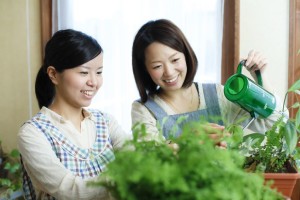Indoor Gardening at Home Doesn’t Require Much Space But Reaps Big Rewards
 If you long for the lush green of a garden during the bleak months of winter, or if you’re looking for a way to exercise your green thumb inside, consider an indoor garden. Gardening at home isn’t limited to your backyard but, instead, can bring all the benefits of an outdoor garden inside for you to enjoy.
If you long for the lush green of a garden during the bleak months of winter, or if you’re looking for a way to exercise your green thumb inside, consider an indoor garden. Gardening at home isn’t limited to your backyard but, instead, can bring all the benefits of an outdoor garden inside for you to enjoy.
Here are some easy guidelines for getting started gardening at home with some indoor plantings:
Any size space is appropriate for your indoor garden: You don’t need a large area to get started with your plants. If space is limited, try a windowsill or a small set of shelves and try just a few varieties. Even a plant or two can improve the air quality in your home and provide the visual appeal that live plants contribute to any room.
Consider lighting options: One of the challenges of an indoor garden is making sure your plants have adequate light to grow. Different plants require different light levels, of course, so you’ll want to plant species that will grow well together with similar light needs. A regular light bulb won’t work to give your plants the ability to engage in photosynthesis, because you need the same wavelengths as the rays the sun produces.
There are many varieties of lights available, and they each come with a different price tag. While a simple fluorescent light will be adequate for herbs, for example, because they don’t create buds or flowers, vegetables will require something more robust. A High- Intensity Discharge bulb is ideal, but they can be expensive. High-Pressure Sodium bulbs produce an orange light that is good for flowers and with a longer life, they are more economical than some other options.
Check your temps and humidity: The ideal temperature for an indoor garden when gardening at home is between 65 and 75 degrees. Thankfully, that’s a pretty comfortable temperature range for people, too, but you can also vary it by around ten degrees if necessary.
Humidity can become a concern with indoor gardens, because winter brings the dry heat of the furnace. Be sure to mist your plants, or you can place a water tray near your plants, adding lava rocks for an increased evaporation area. Don’t place your plants in a tray of water, though, because they still require adequate drainage.
No matter where you’re planning to create a garden, it’s best if you can easily identify each variety you’ve planted. Kincaid Plant Markers provide an easy and attractive way to label each plant in your backyard or in your indoor garden.
